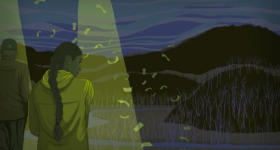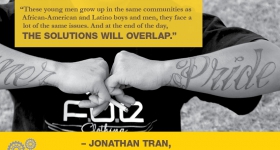Wedding photograph of Wong Lan Fong and Yee Shew Ning, 1926. Photo credit: US National Archives and Records Administration.
When I was a senior at the College of William and Mary in 2008, I was part of the first class in Asian American studies. Strangely, the class was not part of the history department, but theater. The professor, who was also an actor and playwright, fought hard for an Asian American Studies curriculum at the college. Years after I graduated, he succeeded, and students can now take courses on Asian American topics at W&M.
That single, yet seminal class shaped much of the way I now view immigration, history, identity, and culture. While it was not the first time I’d heard about Japanese internment camps, it was the first time I truly learned about it. It was also the first time I learned about Asian Americans who had been in the United States for generations. Even though my own American connection only began when my parents immigrated in the ‘80s, there was something about these stories that struck a chord with me. I was hooked.
When I spoke with University of Minnesota history professor Erika Lee about her involvement with the “Attachments: Faces and Stories from America’s Gates” exhibit at the National Archives, her interest in the role of Asian Americans in United States history began in a similar way.
“I grew up at a time where there were not Asian American Studies in colleges,” Lee said. “It wasn’t until college that I first learned about Asian American history. In high school, there was no mention of Asian Americans in US history at all! So when I got to college, I took immigration classes, and classes on California history. I had two reactions: Wow! And Why? Why haven’t I learned about this before? There was a huge desire to add on and re-center Asian American history.”
In her research, Lee was most taken aback by the fact that, at one point in US history, the Chinese were excluded from entering the country.
“I had not known that. I hadn’t learned about that at all,” she said. “There’s a phenomenon in US history where fighting discrimination has become recognized as essential in civil rights. But a generation ago, this was completely absent in US history books.”
As a graduate student at the University of California, Berkeley, Lee's research on the Chinese Exclusion Era took her to the National Archives at San Bruno. Her timing was impeccable: a new batch of Alien Files -- files that can contain all documents pertaining to a person’s entry into the US and subsequent actions -- had just been released, and she would be the first researcher to look through those files in 70 years.
To her absolute surprise, she found the file of her own grandparents, who arrived in the US during the time when US immigration policy explicitly barred Chinese immigrants. A wedding photo fell out from her grandmother’s file, a photo submitted as evidence of her marriage to Lee’s grandfather. Since it was the only copy, it was the first time Lee had ever seen it.
“I was really, really lucky to have such a treasure trove available to me,” Lee said. From her research, she produced two books on Asian American immigration. She says that understanding what happened to immigrants at Angel Island is extremely relevant to today’s issues.
“The debate over immigration: is it good or bad for the country? Which immigrants are good? Which are bad? Then, how do we process them?” she said. “There are still huge numbers of people who’d like to make the United States their home. Even the Founding Fathers had this discussion. What ‘Attachments’ does is personalize these stories. What happens when a person comes to this country? What IDs do they need to provide? Proofs of residence? Then there is the tension that arises. How do laws get translated, enforced, and what does it mean for the immigrants?”
So thorough was Lee’s work on immigration, she was tapped by curator Bruce Bustard to be a consultant on the ‘Attachments’ exhibit at the National Archives. Her grandmother’s story is included in the exhibit. Working on the exhibit was, for Lee, personally and professionally gratifying.
“It is absolutely amazing. My grandmother’s photo is part of a huge banner outside the building. I was very excited to see this, because for me and for my family, it really represents this moment and the feelings and struggles my grandmother faced, the many milestones achieved and barriers overcome. It’s an American success story,” she said, deeply moved. “To see her story at the Archives in the same building as the Declaration of Independence, Constitution, and the Bill of Rights -- words fail me to describe what that feels like. When I saw her photo hanging on the banner, I was very emotional, and I wasn’t prepared for that.
“I’m very grateful for my grandparents, for all the immigrants who’ve come. I’m certain that this is a story that deserves to be told in our nation’s history, and in our capitol. This is not about the past. This is about the present.”
The Attachments exhibit is on display through September 4 at the National Archives in Washington, DC.










Comments